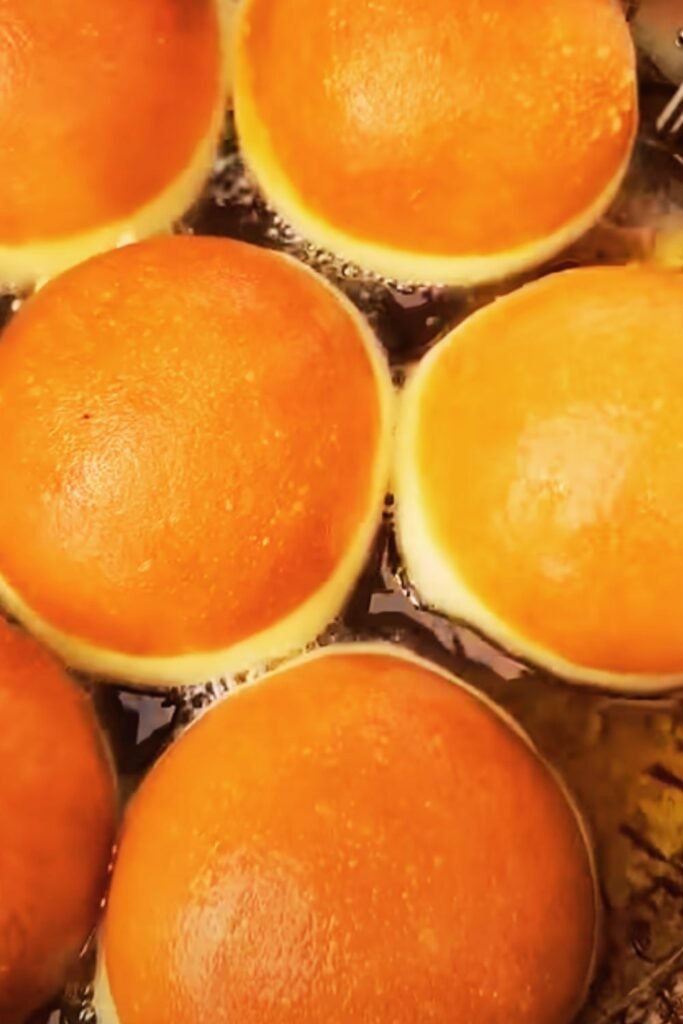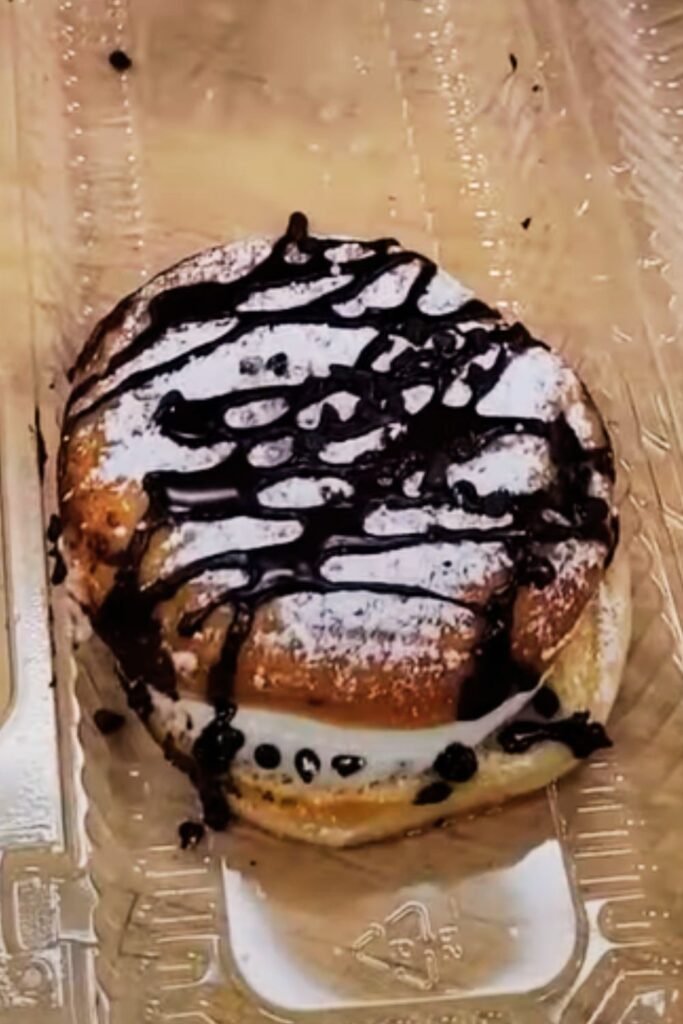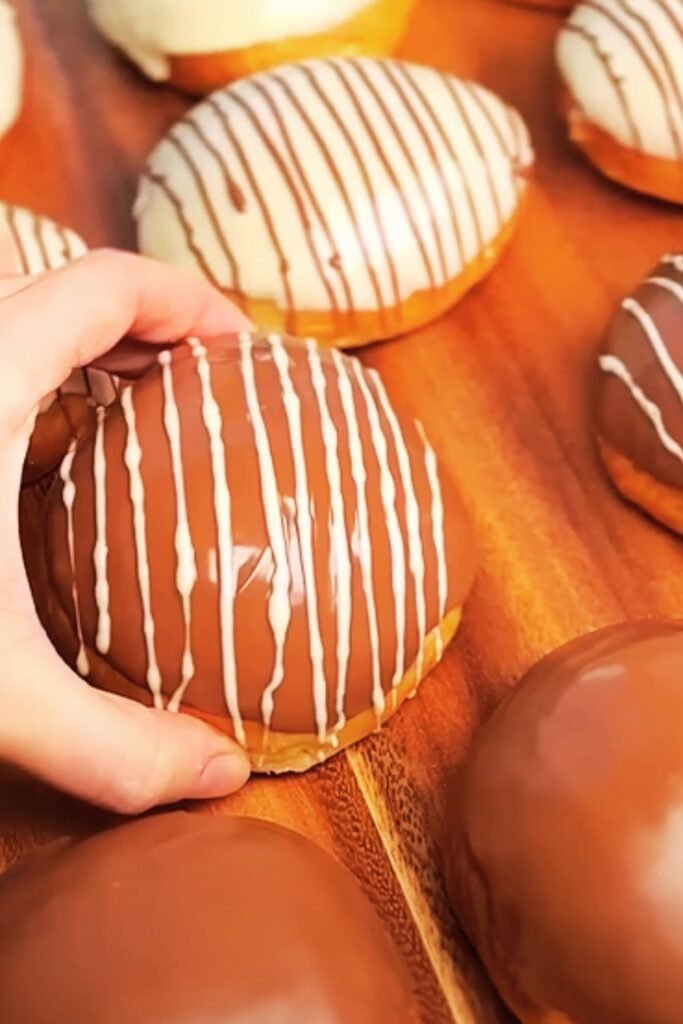Have you ever bitten into a perfectly light, sugar-dusted Italian doughnut filled with smooth, rich pastry cream? If you haven’t experienced the joy of eating bomboloni alla crema, you’re in for a treat! I’ve spent years perfecting this recipe, and today I’m sharing all my secrets for creating these heavenly Italian pastries in your own kitchen.
Bomboloni (the plural of bombolone) are traditional Italian filled doughnuts that have gained worldwide popularity for good reason. Unlike American doughnuts, these pillowy delights are yeast-raised, giving them an airy texture that pairs perfectly with the luscious pastry cream filling. They’re a staple in Italian bakeries and a beloved breakfast or afternoon snack throughout Italy.
In this comprehensive guide, I’ll walk you through every step of creating these delectable treats, from preparing the perfect dough to filling them with silky crema pasticcera (Italian pastry cream). So put on your apron, and let’s dive into the wonderful world of bomboloni!
What Are Bomboloni?
Before we get to the recipe, let’s understand what makes bomboloni special:
Bomboloni : Traditional Italian doughnuts that are yeast-leavened, fried, and typically filled with pastry cream or jam Origin : Believed to have originated in Tuscany, Italy Texture : Light, fluffy interior with a slight chew and a delicate crisp exterior Flavor : Subtly sweet dough complemented by rich fillings Appearance : Round with a characteristic pale line around the middle (the “equator”)
These delightful pastries differ slightly from region to region in Italy. In some areas, they’re larger and flatter, while in others, they’re plumper and more spherical. The version I’m sharing today is closest to what you’d find in Florence, with a perfect balance of dough to filling.
Tools You’ll Need
Before diving into the recipe, make sure you have these essential tools on hand:
- Stand mixer with dough hook attachment (or strong arms for kneading!)
- Digital kitchen scale for precision
- Large mixing bowls
- Rolling pin
- 3-inch round cookie cutter
- Candy/deep-fry thermometer
- Heavy-bottomed pot for frying
- Slotted spoon or spider strainer
- Pastry bags and tips for filling
- Cooling rack
- Parchment paper
Ingredients
For the Dough:
| Ingredient | Amount | Notes |
|---|---|---|
| All-purpose flour | 500g (4 cups) | High-quality flour will yield better results |
| Active dry yeast | 7g (2¼ tsp) | Can substitute with instant yeast (use 5g) |
| Granulated sugar | 100g (½ cup) | Provides sweetness and food for the yeast |
| Warm milk | 200ml (¾ cup + 2 tbsp) | Temperature should be 105-110°F (40-43°C) |
| Eggs | 2 large | Room temperature |
| Egg yolks | 2 | For extra richness |
| Unsalted butter | 80g (⅓ cup) | Softened, room temperature |
| Lemon zest | From 1 lemon | Adds a subtle aromatic note |
| Vanilla extract | 2 tsp | Use pure, not imitation |
| Salt | 5g (1 tsp) | Essential for flavor balance |
| Vegetable oil | For frying | Approximately 2 liters (8 cups) |
| Granulated sugar | For coating | About 200g (1 cup) |
For the Pastry Cream (Crema Pasticcera):
| Ingredient | Amount | Notes |
|---|---|---|
| Whole milk | 500ml (2 cups) | Full-fat for richness |
| Granulated sugar | 150g (¾ cup) | Divided use |
| Egg yolks | 6 large | Room temperature |
| Cornstarch | 40g (⅓ cup) | For thickening |
| Vanilla bean | 1 pod | Split and scraped (or 2 tsp vanilla extract) |
| Lemon zest | From ½ lemon | Optional but traditional |
| Salt | Pinch | Enhances flavor |
| Unsalted butter | 30g (2 tbsp) | Cold, cut into small pieces |
Step-by-Step Instructions
Preparing the Dough
- Activate the yeast: In the bowl of your stand mixer, combine warm milk (105-110°F/40-43°C) with 1 tablespoon of the measured sugar. Sprinkle the yeast over the top and let it sit for 5-10 minutes until foamy. If the yeast doesn’t foam, it may be dead, and you’ll need to start again with fresh yeast.
- Mix the wet ingredients: Add the eggs, egg yolks, remaining sugar, vanilla extract, and lemon zest to the yeast mixture. Mix with a fork until well combined.
- Add dry ingredients: Add the flour and salt to the wet ingredients. Using the dough hook attachment, mix on low speed until the dough starts to come together, about 2-3 minutes.
- Incorporate butter: With the mixer running on medium-low speed, add the softened butter, one tablespoon at a time, waiting until each addition is fully incorporated before adding the next. This process should take about 5 minutes.
- Knead the dough: Increase the speed to medium and knead for 8-10 minutes until the dough is smooth, elastic, and pulls away from the sides of the bowl. It will still be slightly sticky, but should pass the “windowpane test” – if you take a small piece of dough and stretch it between your fingers, it should stretch thin enough to see light through without tearing.
- First rise: Transfer the dough to a lightly oiled bowl, cover with plastic wrap or a damp kitchen towel, and let it rise in a warm place until doubled in size, about 1-2 hours depending on the room temperature.

Shaping the Bomboloni
- Prepare your workspace: Line two baking sheets with parchment paper and dust them lightly with flour.
- Roll out the dough: After the dough has doubled in size, turn it out onto a lightly floured surface. Using a rolling pin, gently roll the dough to a thickness of about ½ inch (1.25 cm). Be careful not to press out all the air.
- Cut dough rounds: Using a 3-inch (7.5 cm) round cutter, cut out as many circles as possible. Place them on the prepared baking sheets, leaving about 2 inches between each one.
- Re-roll scraps: Gather the dough scraps, knead them gently together, and let rest for 10 minutes before rolling out again and cutting more rounds. You should get about 16-18 bomboloni in total.
- Second rise: Cover the dough rounds with a damp kitchen towel or loose plastic wrap and let them rise for another 30-45 minutes until puffy and nearly doubled in size.
Making the Crema Pasticcera (Pastry Cream)
While the dough is rising for the second time, prepare the pastry cream:
- Prepare egg mixture: In a medium bowl, whisk together the egg yolks, half of the sugar (75g), cornstarch, and a pinch of salt until pale and thickened.
- Heat the milk: In a medium saucepan, combine the milk, remaining sugar (75g), vanilla bean (split and scraped), and lemon zest if using. Heat over medium heat until it just begins to simmer, stirring occasionally to dissolve the sugar.
- Temper the eggs: Remove the vanilla bean pod from the milk. Slowly pour about one-third of the hot milk into the egg mixture, whisking constantly to prevent the eggs from cooking. Pour the tempered egg mixture back into the saucepan with the remaining milk.
- Cook the cream: Return the saucepan to medium-low heat and cook, whisking constantly, until the mixture thickens and comes to a gentle boil. Continue cooking for 1-2 minutes more, still whisking. The cream should be thick enough to coat the back of a spoon.
- Finish the cream: Remove from heat and whisk in the cold butter pieces until melted and fully incorporated.
- Strain and cool: Pass the cream through a fine-mesh strainer into a clean bowl to remove any lumps or bits of cooked egg. Cover the surface directly with plastic wrap to prevent a skin from forming. Let cool completely in the refrigerator, at least 2 hours or overnight.
Frying the Bomboloni
- Prepare for frying: Fill a heavy-bottomed pot with about 2 inches of vegetable oil. Heat the oil to 350°F (175°C), using a candy/deep-fry thermometer to monitor the temperature.
- Prepare workspace: Place a cooling rack over a baking sheet lined with paper towels. Put the granulated sugar for coating in a shallow dish.
- Fry in batches: Carefully lower 3-4 bomboloni into the hot oil using a slotted spoon or spider strainer. Fry for about 2 minutes on each side until they’re golden brown. Monitor the oil temperature throughout and adjust the heat as needed to maintain 350°F.
- Drain and sugar: Remove the bomboloni with the slotted spoon and place them on the cooling rack for a few seconds to drain excess oil. While still warm, roll them in the granulated sugar to coat completely.
- Cool slightly: Allow the bomboloni to cool until just warm to the touch, about 10-15 minutes, before filling.

Filling the Bomboloni
- Prepare the pastry cream: Remove the chilled pastry cream from the refrigerator and whisk it vigorously until smooth. Transfer to a pastry bag fitted with a small round tip or a filling tip.
- Create an entry point: Using a small knife, make a small hole in the side of each bombolone, cutting about halfway into the center.
- Fill the bomboloni: Insert the pastry bag tip into the hole and gently squeeze, filling each bombolone with pastry cream until you feel resistance. You’ll know they’re adequately filled when the bomboloni feel heavier and the cream just starts to peek out of the hole.
- Finishing touch: If desired, dust the filled bomboloni lightly with powdered sugar just before serving.

Tips for Perfect Bomboloni
Dough Success
- Temperature matters: All refrigerated ingredients should be at room temperature before starting to ensure proper dough development.
- Windowpane test: To check if your dough is properly kneaded, take a small piece and stretch it between your fingers. If it stretches thin enough to see light through without tearing, it’s ready.
- Patience with rising: Don’t rush the rising process. The longer, slower rise develops better flavor and texture.
- Handle gently: After the first rise, handle the dough delicately to preserve the air bubbles that give bomboloni their light texture.
Frying Tips
- Temperature control: Maintaining the correct oil temperature is crucial. Too hot, and the bomboloni will brown too quickly without cooking inside; too cool, and they’ll absorb excess oil and become greasy.
- Oil quality: Use a neutral oil with a high smoke point like vegetable, canola, or sunflower oil.
- Don’t overcrowd: Fry in small batches to maintain oil temperature and give the bomboloni room to expand.
- The “equator” line: A pale line around the middle of each bombolone is traditional and indicates they’ve been fried correctly.
Pastry Cream Perfection
- Constant whisking: Never stop whisking the pastry cream while it’s on the heat to prevent lumps and scorching.
- Strain always: Even if you think your cream is perfectly smooth, straining removes any small bits of cooked egg or lumps of cornstarch.
- For extra smoothness: After refrigeration, you can whip the cold cream with an electric mixer for 30 seconds to make it ultra-smooth before filling.
Storage and Make-Ahead Options
Bomboloni are best enjoyed the day they’re made, preferably within a few hours of frying. However, here are some options for making components ahead:
- Dough: Can be made the day before and refrigerated after the first rise. Let it come to room temperature for 30 minutes before rolling and cutting.
- Pastry cream: Can be made up to 3 days ahead and stored in an airtight container in the refrigerator.
- Unfilled bomboloni: Will stay fresh for about 24 hours in an airtight container at room temperature.
- Filled bomboloni: Best consumed immediately but can be stored in the refrigerator for up to 12 hours; bring to room temperature before serving.
Variations
While traditional bomboloni alla crema are filled with vanilla pastry cream, there are many delicious variations to explore:
- Chocolate cream: Add 100g of melted dark chocolate to the finished pastry cream while it’s still warm.
- Coffee cream: Infuse the milk with 2 tablespoons of coffee beans before making the pastry cream, or add 1 tablespoon of espresso powder.
- Fruit preserves: For a quicker option, fill with high-quality fruit preserves instead of pastry cream. Raspberry is traditional, but any flavor works.
- Nutella: For a crowd-pleasing option, fill with slightly warmed Nutella.
- Citrus cream: Add the zest of one orange or two lemons to the pastry cream for a brighter flavor.
Serving Suggestions
Bomboloni alla crema are traditionally enjoyed in Italy as:
- A breakfast treat alongside a cappuccino or caffè latte
- An afternoon snack (merenda) with espresso
- A dessert served with fresh berries on the side
- A special offering for celebrations and gatherings
- A sweet ending to a classic Italian dinner
For an elegant dessert presentation, place a bombolone on a plate with a small spoonful of berry compote and a light dusting of powdered sugar.
Common Problems and Solutions
| Problem | Possible Cause | Solution |
|---|---|---|
| Dense, heavy bomboloni | Underproofed dough or overworked after rising | Allow more time for rising; handle dough more gently |
| Greasy bomboloni | Oil temperature too low | Keep oil at a steady 350°F (175°C) |
| Doughnuts browning too quickly | Oil temperature too high | Lower heat; verify with thermometer |
| Pastry cream is lumpy | Eggs curdled or insufficient whisking | Strain cream; whisk constantly while cooking |
| Bomboloni deflating when handled | Dough overproofed | Watch rising time carefully; poke test should leave slight indentation |
| Filling leaking out | Too much filling or weak spot in dough | Fill just until resistance is felt; check for thin spots before frying |
Frequently Asked Questions
Can I make bomboloni without a stand mixer? Yes! You can mix and knead the dough by hand, though it will require about 15 minutes of vigorous kneading to develop the proper gluten structure.
Can I bake these instead of frying? While traditional bomboloni are fried, you can bake them at 375°F (190°C) for about 12-15 minutes. The texture will be different – more like brioche rolls than doughnuts – but still delicious.
Why didn’t my dough rise? Check that your yeast is fresh and that your milk wasn’t too hot (which would kill the yeast). The environment should also be warm – around 75-80°F (24-27°C) is ideal for rising.
Can I freeze bomboloni? Unfilled bomboloni can be frozen for up to a month. Thaw at room temperature and refresh in a 300°F (150°C) oven for 5 minutes before filling. I don’t recommend freezing filled bomboloni.
Why does my pastry cream have lumps? This usually happens when the eggs cook too quickly. Make sure to temper the eggs by gradually adding hot milk, whisking constantly, and strain the finished cream to remove any lumps.
Can I make mini bomboloni? Absolutely! Use a smaller cutter (about 2 inches) and reduce the frying time to about 1-1.5 minutes per side.
How do I know when the oil is the right temperature without a thermometer? Drop a small piece of dough into the oil. It should sizzle immediately and rise to the surface within a few seconds, but not darken too quickly.
My bomboloni don’t have the white “equator” line. What went wrong? The white line appears when the bomboloni rise properly during frying. Make sure your dough is sufficiently proofed and that you’re frying at the correct temperature.
A Final Note
Creating bomboloni at home is truly a labor of love, but the results are well worth the effort. There’s something magical about watching these little dough rounds puff up in the hot oil, then biting into the sugar-crusted exterior to reveal the creamy center. While they might not be perfect the first time you make them, each batch will get better as you become familiar with the dough and the frying process.
I hope this recipe brings a taste of Italian pastry tradition to your kitchen. Whether you’re making these for a special breakfast, a dessert for guests, or just because you deserve a treat, these bomboloni alla crema are sure to bring smiles and possibly a few moments of pastry-induced bliss.
Buon appetito!